The Gel Imaging Documentation Market is estimated to be valued at USD 327.8 billion in 2025 and is projected to reach USD 453.5 billion by 2035, registering a compound annual growth rate (CAGR) of 3.3% over the forecast period.
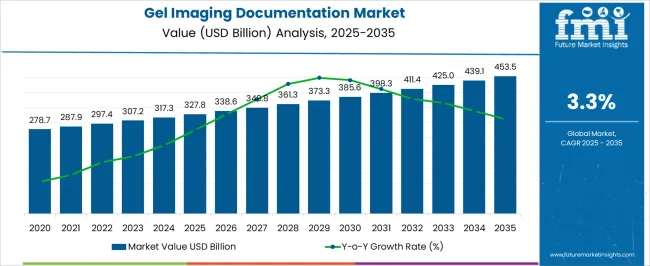
| Metric | Value |
|---|---|
| Gel Imaging Documentation Market Estimated Value in (2025 E) | USD 327.8 billion |
| Gel Imaging Documentation Market Forecast Value in (2035 F) | USD 453.5 billion |
| Forecast CAGR (2025 to 2035) | 3.3% |
The gel imaging documentation market is experiencing significant growth, driven by rising demand for advanced molecular biology tools in research and clinical applications. The increased adoption of gel imaging systems is being supported by their ability to provide high-resolution results, streamline workflows, and improve accuracy in protein and nucleic acid analysis.
Growing investments in life sciences research, expansion of genomic and proteomic studies, and increasing applications in drug discovery are further stimulating demand. Technological advancements in imaging platforms, such as the integration of digital systems, automated analysis software, and enhanced detection sensitivity, are improving the efficiency and reproducibility of laboratory processes.
The market is also being influenced by the growing requirement for compliance with regulatory standards in clinical and pharmaceutical laboratories, which drives the need for accurate and standardized documentation systems As research institutions and biopharmaceutical companies continue to expand their R&D capabilities, the gel imaging documentation market is expected to witness sustained growth, with manufacturers focusing on innovation and system upgrades to meet evolving scientific requirements.
The gel imaging documentation market is segmented by system type, component, application, and geographic regions. By system type, gel imaging documentation market is divided into Digital Gel Imaging System and Film Gel Imaging Systems. In terms of component, gel imaging documentation market is classified into Systems, Software, and Accessories. Based on application, gel imaging documentation market is segmented into Chemiluminiscence, Fluorescence, Colorimetry, Gel Documentation, and Protein Analysis. Regionally, the gel imaging documentation industry is classified into North America, Latin America, Western Europe, Eastern Europe, Balkan & Baltic Countries, Russia & Belarus, Central Asia, East Asia, South Asia & Pacific, and the Middle East & Africa.
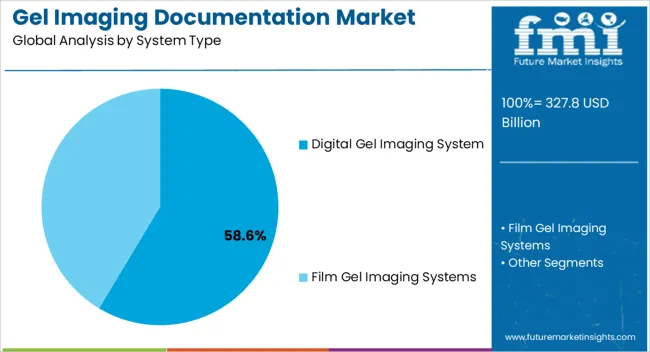
The digital gel imaging system segment is projected to capture 58.6% of the gel imaging documentation market revenue share in 2025, making it the dominant system type. Its leadership is being driven by the increasing shift from manual and semi-automated platforms to advanced digital systems that provide higher sensitivity, resolution, and automation capabilities. Digital systems offer rapid image acquisition and precise quantification, which significantly improve the efficiency of research workflows.
Laboratories are adopting these systems to reduce manual errors and ensure reproducibility in complex molecular biology experiments. Enhanced connectivity with data management software and compatibility with cloud platforms are further supporting the integration of digital imaging systems into modern laboratory infrastructures.
Their ability to handle a wide range of applications, including DNA, RNA, and protein analysis, makes them versatile solutions across academic, clinical, and pharmaceutical research settings The growing emphasis on data accuracy, traceability, and compliance with international research standards is reinforcing the dominance of digital gel imaging systems in the global market.
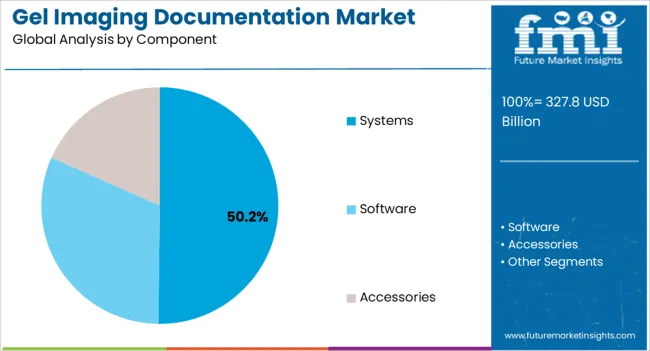
The systems component segment is anticipated to account for 50.2% of the gel imaging documentation market revenue share in 2025, establishing it as the leading component category. Its prominence is being reinforced by the rising demand for complete integrated solutions that include imaging platforms, analysis software, and detection modules in a single package. Researchers and laboratory professionals prefer systems that deliver end-to-end solutions for gel documentation, enabling higher efficiency and standardization of processes.
The growth of this segment is supported by continuous innovations in imaging technology, such as enhanced optical systems, higher resolution sensors, and advanced fluorescence and chemiluminescence detection capabilities. In addition, the growing trend toward automation in research laboratories is encouraging the adoption of fully integrated systems that minimize manual intervention and improve reproducibility.
Systems also provide scalability, allowing laboratories to expand their capabilities through modular upgrades and software extensions The increasing need for reliable, compliant, and user-friendly platforms is expected to sustain the strong market position of the systems component segment in the coming years.
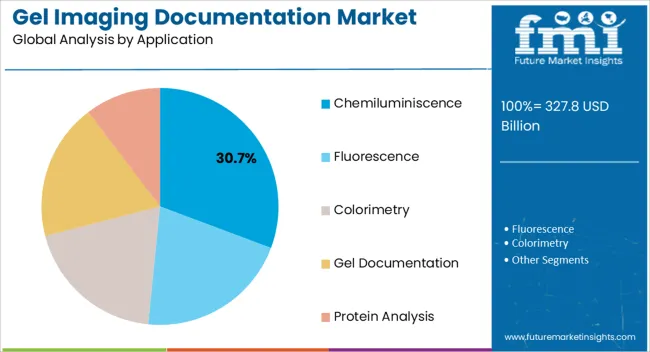
The chemiluminescence application segment is expected to hold 30.7% of the gel imaging documentation market revenue share in 2025, making it the leading application area. Its leadership is being influenced by the superior sensitivity and dynamic range of chemiluminescence detection, which allows for precise quantification of low-abundance proteins and biomolecules. This application is widely adopted in molecular biology and proteomics due to its ability to provide accurate and reproducible results for Western blotting and related techniques.
Growing reliance on chemiluminescence imaging is also being supported by advances in detection reagents and substrates, which improve signal stability and enhance assay performance. The segment’s growth is being further reinforced by increasing applications in pharmaceutical research, diagnostics, and clinical laboratories, where sensitivity and accuracy are critical.
Automated chemiluminescence imaging systems are enabling high-throughput workflows, reducing analysis time while maintaining precision As demand for sensitive and reliable imaging solutions increases, the chemiluminescence application segment is expected to remain a central driver of growth within the gel imaging documentation market.
The global gel imaging documentation market size is anticipated to be worth US$ 297.38 Mn in 2025. During the projection period of 2025 to 2035, the market is predicted to grow at a CAGR of 3.3%, with an anticipated valuation of US$ 406.47 Mn by 2035.
| Attributes | Details |
|---|---|
| Market Value (2025) | US$ 297.38 Million |
| Market Forecast Value (2035) | US$ 406.47 Billion |
| Market CAGR (2025 to 2035) | 3.3% |
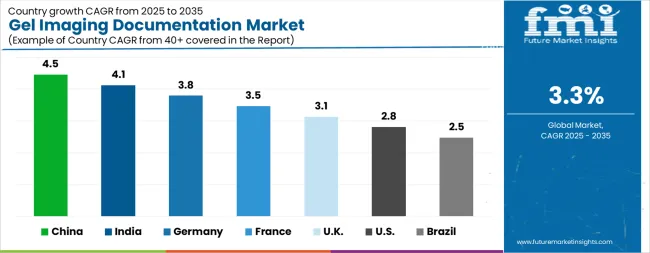
| Country | CAGR |
|---|---|
| China | 4.5% |
| India | 4.1% |
| Germany | 3.8% |
| France | 3.5% |
| UK | 3.1% |
| USA | 2.8% |
| Brazil | 2.5% |
The Gel Imaging Documentation Market is expected to register a CAGR of 3.3% during the forecast period, exhibiting varied country level momentum. China leads with the highest CAGR of 4.5%, followed by India at 4.1%. Developed markets such as Germany, France, and the UK continue to expand steadily, while the USA is likely to grow at consistent rates. Brazil posts the lowest CAGR at 2.5%, yet still underscores a broadly positive trajectory for the global Gel Imaging Documentation Market. In 2024, Germany held a dominant revenue in the Western Europe market and is expected to grow with a CAGR of 3.8%. The USA Gel Imaging Documentation Market is estimated to be valued at USD 119.6 billion in 2025 and is anticipated to reach a valuation of USD 157.7 billion by 2035. Sales are projected to rise at a CAGR of 2.8% over the forecast period between 2025 and 2035. While Japan and South Korea markets are estimated to be valued at USD 16.3 billion and USD 9.2 billion respectively in 2025.
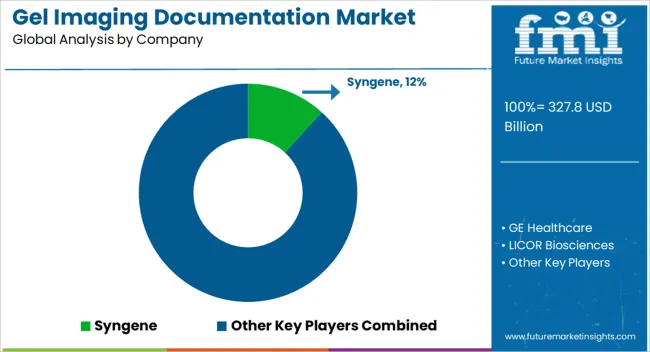
| Item | Value |
|---|---|
| Quantitative Units | USD 327.8 Billion |
| System Type | Digital Gel Imaging System and Film Gel Imaging Systems |
| Component | Systems, Software, and Accessories |
| Application | Chemiluminiscence, Fluorescence, Colorimetry, Gel Documentation, and Protein Analysis |
| Regions Covered | North America, Europe, Asia-Pacific, Latin America, Middle East & Africa |
| Country Covered | United States, Canada, Germany, France, United Kingdom, China, Japan, India, Brazil, South Africa |
| Key Companies Profiled | Syngene, GE Healthcare, LICOR Biosciences, BioRad Laboratories, Thermo Fisher Scientific, Azure Biosystems, Fujifilm, Vilber Lourmat, Amersham, Carl Zeiss, PerkinElmer, VWR Corporation, Alpha Innotech, Nikon, and Molecular Devices |
The global gel imaging documentation market is estimated to be valued at USD 327.8 billion in 2025.
The market size for the gel imaging documentation market is projected to reach USD 453.5 billion by 2035.
The gel imaging documentation market is expected to grow at a 3.3% CAGR between 2025 and 2035.
The key product types in gel imaging documentation market are digital gel imaging system and film gel imaging systems.
In terms of component, systems segment to command 50.2% share in the gel imaging documentation market in 2025.






Our Research Products

The "Full Research Suite" delivers actionable market intel, deep dives on markets or technologies, so clients act faster, cut risk, and unlock growth.

The Leaderboard benchmarks and ranks top vendors, classifying them as Established Leaders, Leading Challengers, or Disruptors & Challengers.

Locates where complements amplify value and substitutes erode it, forecasting net impact by horizon

We deliver granular, decision-grade intel: market sizing, 5-year forecasts, pricing, adoption, usage, revenue, and operational KPIs—plus competitor tracking, regulation, and value chains—across 60 countries broadly.

Spot the shifts before they hit your P&L. We track inflection points, adoption curves, pricing moves, and ecosystem plays to show where demand is heading, why it is changing, and what to do next across high-growth markets and disruptive tech

Real-time reads of user behavior. We track shifting priorities, perceptions of today’s and next-gen services, and provider experience, then pace how fast tech moves from trial to adoption, blending buyer, consumer, and channel inputs with social signals (#WhySwitch, #UX).

Partner with our analyst team to build a custom report designed around your business priorities. From analysing market trends to assessing competitors or crafting bespoke datasets, we tailor insights to your needs.
Supplier Intelligence
Discovery & Profiling
Capacity & Footprint
Performance & Risk
Compliance & Governance
Commercial Readiness
Who Supplies Whom
Scorecards & Shortlists
Playbooks & Docs
Category Intelligence
Definition & Scope
Demand & Use Cases
Cost Drivers
Market Structure
Supply Chain Map
Trade & Policy
Operating Norms
Deliverables
Buyer Intelligence
Account Basics
Spend & Scope
Procurement Model
Vendor Requirements
Terms & Policies
Entry Strategy
Pain Points & Triggers
Outputs
Pricing Analysis
Benchmarks
Trends
Should-Cost
Indexation
Landed Cost
Commercial Terms
Deliverables
Brand Analysis
Positioning & Value Prop
Share & Presence
Customer Evidence
Go-to-Market
Digital & Reputation
Compliance & Trust
KPIs & Gaps
Outputs
Full Research Suite comprises of:
Market outlook & trends analysis
Interviews & case studies
Strategic recommendations
Vendor profiles & capabilities analysis
5-year forecasts
8 regions and 60+ country-level data splits
Market segment data splits
12 months of continuous data updates
DELIVERED AS:
PDF EXCEL ONLINE
Gelatin Filters Market Size and Share Forecast Outlook 2025 to 2035
Gelatin Films Market Size and Share Forecast Outlook 2025 to 2035
Gel Stent Market Size and Share Forecast Outlook 2025 to 2035
Gel-Type Strong Acid Cation Exchange Resin Market Size and Share Forecast Outlook 2025 to 2035
Gel Dryer Market Size and Share Forecast Outlook 2025 to 2035
Gel Warmers Market Size and Share Forecast Outlook 2025 to 2035
Gel Air Fresheners Market Size and Share Forecast Outlook 2025 to 2035
Gellan Gum Market Analysis - Size, Share, and Forecast Outlook 2025 to 2035
Gel Packs Market Size and Share Forecast Outlook 2025 to 2035
Gelatin Substitutes Market Analysis - Size, Share, & Forecast Outlook 2025 to 2035
Gelatin Market Trends - Food, Pharma & Nutritional Growth 2025 to 2035
Gel Implants Market Analysis - Trends, Share & Forecast 2025 to 2035
Gelling Agent Market Insights – Texture & Food Innovation 2025 to 2035
Gelatin Hydrolysates Market
Gel Column Agglutination Test System Market
Sol-Gel Based Skin Treatments Market Size and Share Forecast Outlook 2025 to 2035
Pyrogel Insulation Market Size and Share Forecast Outlook 2025 to 2035
Aerogel Insulation Market Size and Share Forecast Outlook 2025 to 2035
Softgel Capsules Market Overview - Growth & Forecast 2025 to 2035
Aerogel Market Size, Growth, and Forecast for 2025 to 2035

Thank you!
You will receive an email from our Business Development Manager. Please be sure to check your SPAM/JUNK folder too.
Chat With
MaRIA